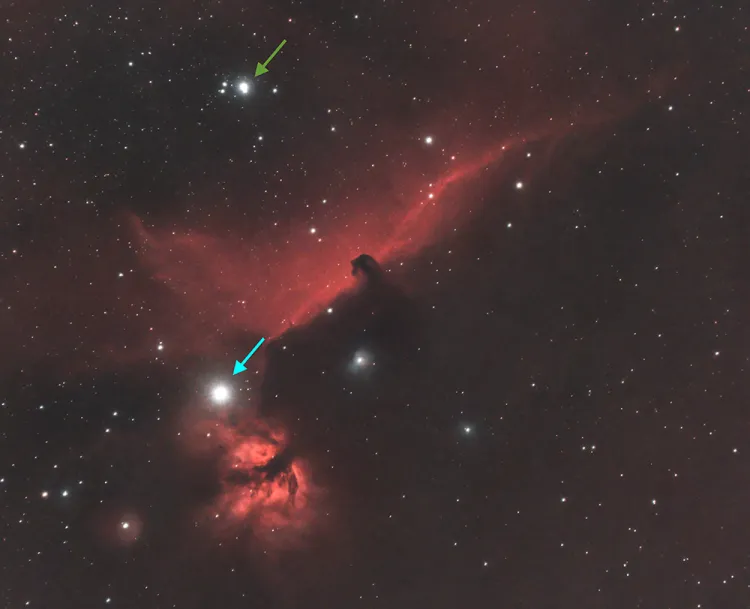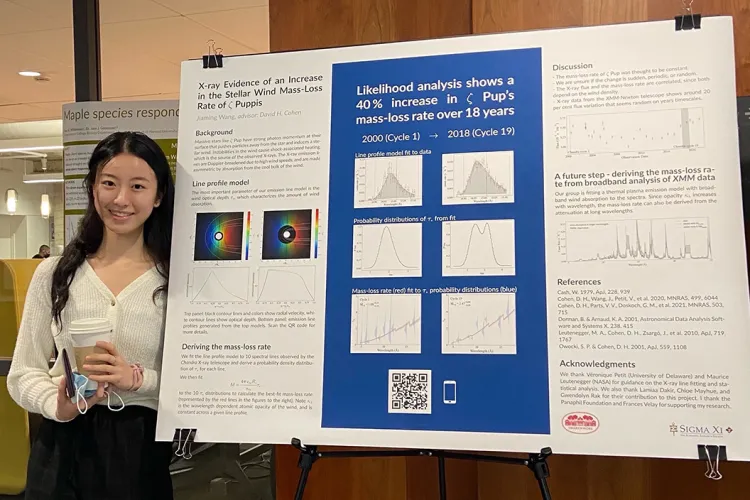Astronomer David Cohen Advances Understanding of Stellar Winds with NASA Grant

From left: Angelina Tjia ’26, Lundy Zheng ’26, and Professor of Astronomy David Cohen.
Professor of Astronomy David Cohen and his research team have spent two dozen years developing techniques for measuring the properties of stellar winds, the streams of gas that flow from massive stars. To advance this research, NASA recently awarded a $300,000, two-year grant for a project titled “X-ray Spectral Diagnostics of Massive Star Winds and Magnetospheres.”
The grant will support Cohen and six Swarthmore students in studying the stellar winds of multiple massive stars, including Alnitak, which is one of Orion’s belt stars, and several stars in the sigma Orionis system, which illuminates the famous Horsehead Nebula. His research students will be completing a pilot study of sigma Ori this fall, and the grant will start in January 2025.
The motivation for this project primarily originated from the work of prior research group members. Winter Parts ’20 and Graham Doskoch ’20 helped develop one of the X-ray measurement techniques. Building on a different technique that Cohen developed along with Emma Wollman ’09, Victoria Wang ’22 made a surprising discovery, published in 2020, that the stellar wind mass-loss rate of the massive star, zeta Puppis, had increased by 40% over the past 20 years.

Horsehead Nebula and surroundings, imaged by Visiting Assistant Professor of Astronomy Jesse Rivera. The blue arrow points at Alnitak and the green arrow points at the sigma Orionis star system.
A significant focus of the new grant is to apply Parts’ and Doskoch’s technique to Chandra X-ray Telescope observations of zeta Puppis to confirm and extend the characterization of the star’s X-ray and stellar wind variability.
“The X-ray measurements provide information about the enrichment of interstellar space with heavy elements,” says Cohen. “The more mass a star loses over time, the more elements (nitrogen, oxygen, potassium, calcium, and iron) it releases into space. These measurements also tell us what the masses of these stars will be when they end their lives in supernova explosions. The lower the mass of a star when it finally explodes, the lower the mass of the black hole it will leave behind.“
The grant supports opportunities for students to work at the NASA Goddard Spaceflight Center in Greenbelt, Md., with project co-investigator Maurice Leutenegger, an expert in X-ray spectroscopy and atomic physics. Cohen and his students will also work closely with Véronique Petit, a professor at the University of Delaware who will train the students in statistical and programming techniques.

Victoria Wang ’22 presents findings at the 2021 Sigma Xi poster session.
Cohen’s current research students, Angelina Tjia ’26 and Lundy Zheng ’26, are completing a pilot study of two of the stars in the sigma Orionis system. His research group takes a holistic approach to doing and learning about science. They discuss the history and context of the problems they work on as well as the field itself, including taking a critical look at the many other activities aside from science that NASA funds — rocket development in collaboration with weapons manufacturers and exploitation of space resources.
Cohen and his students are interested in exploring the ways that ethical issues in more directly human-involved fields such as biology and geology are also relevant to the study of stars. The new NASA grant will provide opportunities and context in which to do that, as well as opportunities to better understand massive stars, their winds, and the cycling of heavy elements through the cosmos.



